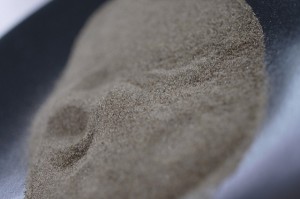Could glass have a role in concrete?
Sometimes, people use the words “cement” and “concrete” interchangeably, but in reality, cement is a component of concrete. Concrete is a combination of aggregate (small stones) and liquid cement that cures or hardens over time. The cement binds the aggregate together and makes what appears to be a uniform surface.
Glass powder could be used as a pozzolan
In cement production, additives (called pozzolans) are combined with the mixture to improve the performance of the cement or give it more desirable qualities. Typically, pozzolans are silica-based or aluminum-based. Pozzolans have been used for thousands of years to improve the performance of cement. In fact, pozzolans of volcanic origin have been found in cements made in ancient Crete and Rome.
Today, pozzolans can be natural or synthetic. Two common pozzolans are fly ash, a by-product of burned coal, and silica fume, a by-product of silica smelting. Coal-fired power plants are a major source of fly ash, but fly ash is becoming scarcer as more coal-fired power plants either shut down or convert to natural gas.
Engineering students at the City College of New York (CCNY) have been experimenting with glass powder as a replacement pozzolan for fly ash. The high silica content of glass gives it a high potential. The researchers used glass powder from colored glass that had no recycling value. Although glass is infinitely recyclable, some glass pieces are too small to recycle, and colored glass must be matched with similarly colored glass before being recycled.
Used as a pozzolan, glass powder has some interesting advantages. The cement production process generates CO2, which is released into the air. Substituting glass powder for fly ash reduces the CO2 emissions associated with cement production.
One question about the use of glass powder as a pozzolan is strength. What impact will the use of glass have on the finished product? The researchers have teamed up with the New York City Department of Design and Construction to test the substitute in action. In May, the Department laid down some concrete sidewalk in South Jamaica, NY that uses the new glass-based cement. The City and the researchers will observe the performance of the concrete over time.
CCNY researchers aren’t the only ones looking at the material strength of glass in cement. A research team from the University of British Columbia is experimenting with the combination of polymers, fly ash and glass powder as a potential replacement for some volume of aggregate materials in concrete. The team has determined that it may be able to replace as much as 25% of the aggregate with the glass powder mixture.
Innovative uses for glass can help keep the material out of landfills, even when recycling it back into container glass is no longer an option. We’re not sure what the decorating value of glass powder is, but if you’re considering working with larger pieces of glass and want some inspiration, please check out the rest of our site. If you’d like to purchase Glassprimer™ glass paint, please visit our online store .
Photo Credit: Hideya Hamano, via Flickr.com

